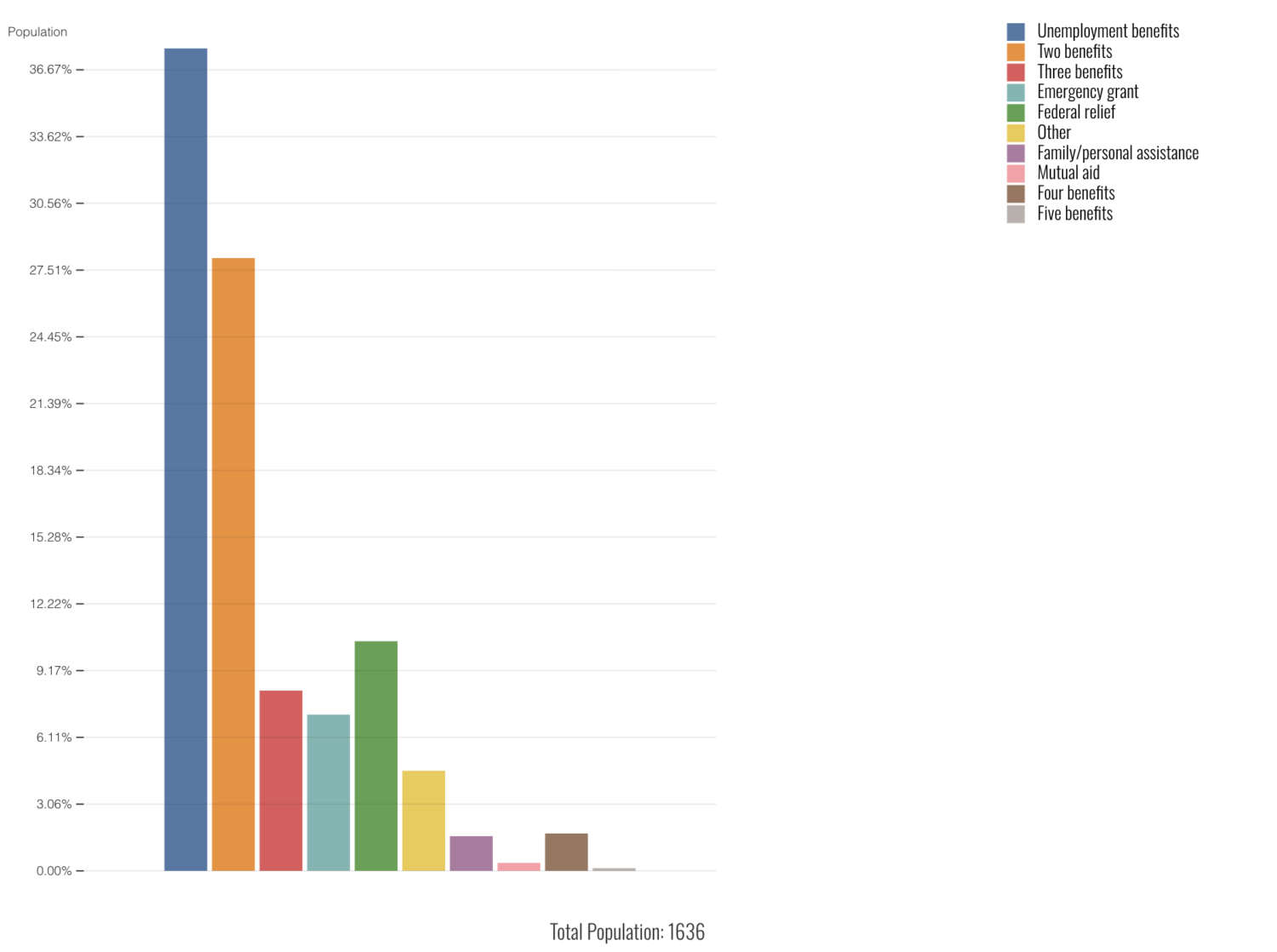By Joanna Woronkowicz
Learning about Immigrant Artists through Creatives Rebuild New York Data
I grew up both as an immigrant and as an artist—a musical theatre actor. These two identities have always felt intertwined, not just because they shaped who I am, but because navigating each world required creativity, resilience, and a deep understanding of how to build a life without a clear roadmap.
In addition to $250 and three kids, my parents, like many others, came to the U.S. with a deep well of talent and ambition—but without the traditional networks or institutions many Americans rely on. My dad, an engineer, and my mom, an economist, had to chart their own paths, building careers through informal networks and sheer persistence. I watched them navigate jobs below their skill level, quickly adapt to new cultural norms, and stretch every dollar by relying on their own ingenuity. When I eventually chose to pursue a career as an artist, it wasn’t surprising to me that success required creativity far beyond the canvas—it meant forging new paths where formal structures were absent.
Today, new data from Creatives Rebuild New York (CRNY) allows us to build on these personal observations with a systematic view. Through their ambitious Guaranteed Income for Artists initiative—one of the largest of its kind nationally—CRNY collected extensive baseline information from more than 13,000 artist applicants across New York State via the Portrait of Artists (PoA) survey. Roughly 2,400 of these artists, about 18% of the pool, identified as immigrants. This dataset offers a rare glimpse into how immigrant artists are navigating economic pressures, forging creative careers, and sustaining their artistic identities, often outside of traditional institutional frameworks.
Relying on Different Systems of Support
Start with the basics: health insurance. Among immigrant applicants to CRNY, about 23% reported having no health insurance coverage—compared to 16% among non-immigrant applicants.
New York State Artists Without Health Insurance (in Blue)

Source: Portrait of New York State Artists (PoA) Survey Data, Creatives Rebuild New York. Created at ArtsAnalytics.org.
This difference is consistent with broader national patterns. According to the Kaiser Family Foundation, noncitizens in the U.S. are significantly more likely to be uninsured or underinsured, reflecting both eligibility restrictions and the employment patterns common among immigrant populations. Many immigrant artists, like other immigrant workers, are more likely to engage in freelance, gig, or self-employed work—roles that typically do not offer employer-provided benefits.
The data from CRNY also help shed light on how immigrant artists navigated economic shocks like the COVID-19 pandemic. Whereas many workers were able to access unemployment insurance, immigrant artists often faced obstacles likely due to citizenship status, documentation issues, or their employment structures. Not only were immigrant artists less likely to receive emergency support, but the evidence suggests they relied more heavily on alternative sources of support, such as emergency relief grants provided by nonprofit organizations, local arts councils, and mutual aid networks. Whereas around 43% of non-immigrant artists received unemployment benefits, only 37% of immigrants artists did. Again, a modest difference, but couple this with the fact that 8-9% of immigrant artists received emergency grants and mutual aid versus 3-4% of non-immigrant artists and we can start to see patterns the differentiate these groups.
New York State Immigrant Artists’ Support Sources during COVID-19 Pandemic

Source: Portrait of New York State Artists (PoA) Survey Data, Creatives Rebuild New York. Created at ArtsAnalytics.org.
Together, these patterns suggest that immigrant artists often operate within different institutional frameworks than non-immigrant artists—drawing on less formalized, more community-based forms of support when traditional systems are not accessible. The CRNY data offer a clearer view of how these dynamics play out in real time and help broaden our understanding of the structures that immigrant artists rely on to sustain their work.
Financial and Emotional Costs of Limited Support
The CRNY data suggest that immigrant artists face higher levels of financial instability than their non-immigrant peers. Whereas 4% of non-immigrant artists described their financial situation as “stable,” only a little over 2% of immigrant artists did. At the other end of the spectrum, 25% of immigrant artists characterized their situation as “extremely unstable,” compared to 22% of non-immigrant artists. These differences, though modest in percentage terms, point to persistent economic precarity for immigrant artists—even within a broader population already facing financial challenges.
Financial (In)stability Among New York State Immigrant Artists

Source: Portrait of New York State Artists (PoA) Survey Data, Creatives Rebuild New York. Created at ArtsAnalytics.org.
The CRNY data suggest that limited access to institutional support may not only increase economic vulnerability but also shape how artists perceive their futures. Immigrant artists in the dataset consistently reported lower levels of financial stability, and those financial pressures were mirrored by lower scores on measures of agency, optimism, and emotional wellbeing. While causality can’t be confirmed from these data alone, it reflects broader international research indicating that strong social protections are correlated with higher levels of life satisfaction and emotional resilience. According to the OECD’s How’s Life? report, individuals living in countries with more robust welfare systems and public support infrastructures tend to report greater subjective well-being and a stronger sense of control over their lives. In the context of the arts—where careers are often nonlinear and intrinsically motivated—these support structures may be particularly important in sustaining both ambition and emotional health.
Supporting Ingenuity, Not Just Surviving It
The CRNY data offer a valuable window into how immigrant artists navigate careers in the absence of strong institutional support. The patterns are clear: immigrant artists face greater financial instability and report lower levels of wellbeing and agency compared to their non-immigrant peers. But what’s equally evident—if not always measured directly—is their persistence, adaptability, and capacity to create new paths in the face of limited infrastructure.
What if that ingenuity didn’t have to be a survival strategy? One hypothesis that emerges from these findings is that more robust institutional support—healthcare access, public benefits, artist fellowships, and new funding structures—could reduce the need for immigrant artists to constantly chart their own course. Of course, this assumes that both immigrants and non-immigrants have access to these systems in the first place—something the CRNY data suggest is far from guaranteed. With those basic conditions met, the entrepreneurial creativity that many immigrant communities already display could be channeled more fully into artistic innovation and cultural leadership.
There’s good reason to believe this is not just speculation. Research from the Kauffman Foundation shows that immigrants have historically been responsible for a disproportionately high share of new business creation in the U.S., spanning not only tech and science but also education, culture, and the arts. However, more recent data suggest that the rate of immigrant entrepreneurship has plateaued, raising concerns about the future vitality of American innovation and economic growth. Strengthening institutional supports could potentially help ensure that the creative and entrepreneurial potential of immigrant artists continues to fuel new ideas, industries, and cultural contributions across the country. In some ways, the patterns visible in the CRNY data mirror my own experience. Growing up both as an immigrant and an artist, I learned early on what it meant to build a future without a clear roadmap. Over time, I channeled that same drive—the need to learn, to create, to forge new possibilities—not only into the arts but also into work beyond the arts. Part of that energy went into building this site, Arts Analytics, and founding I/O, where we help cultural organizations use research to strengthen their work. It also shaped my work as an academic, using data to better understand the intersection of creative careers and policy.
In the same spirit, the CRNY data on immigrant artists’ experiences offer an important opportunity: to use evidence to better understand creative work and to inform policies that can support it more effectively.
